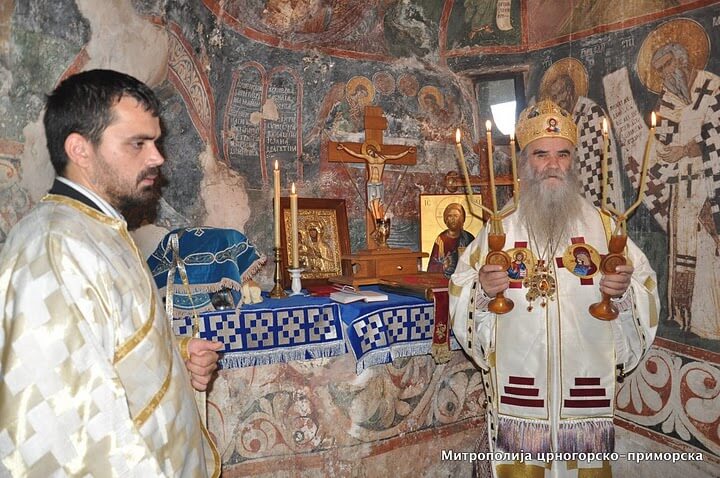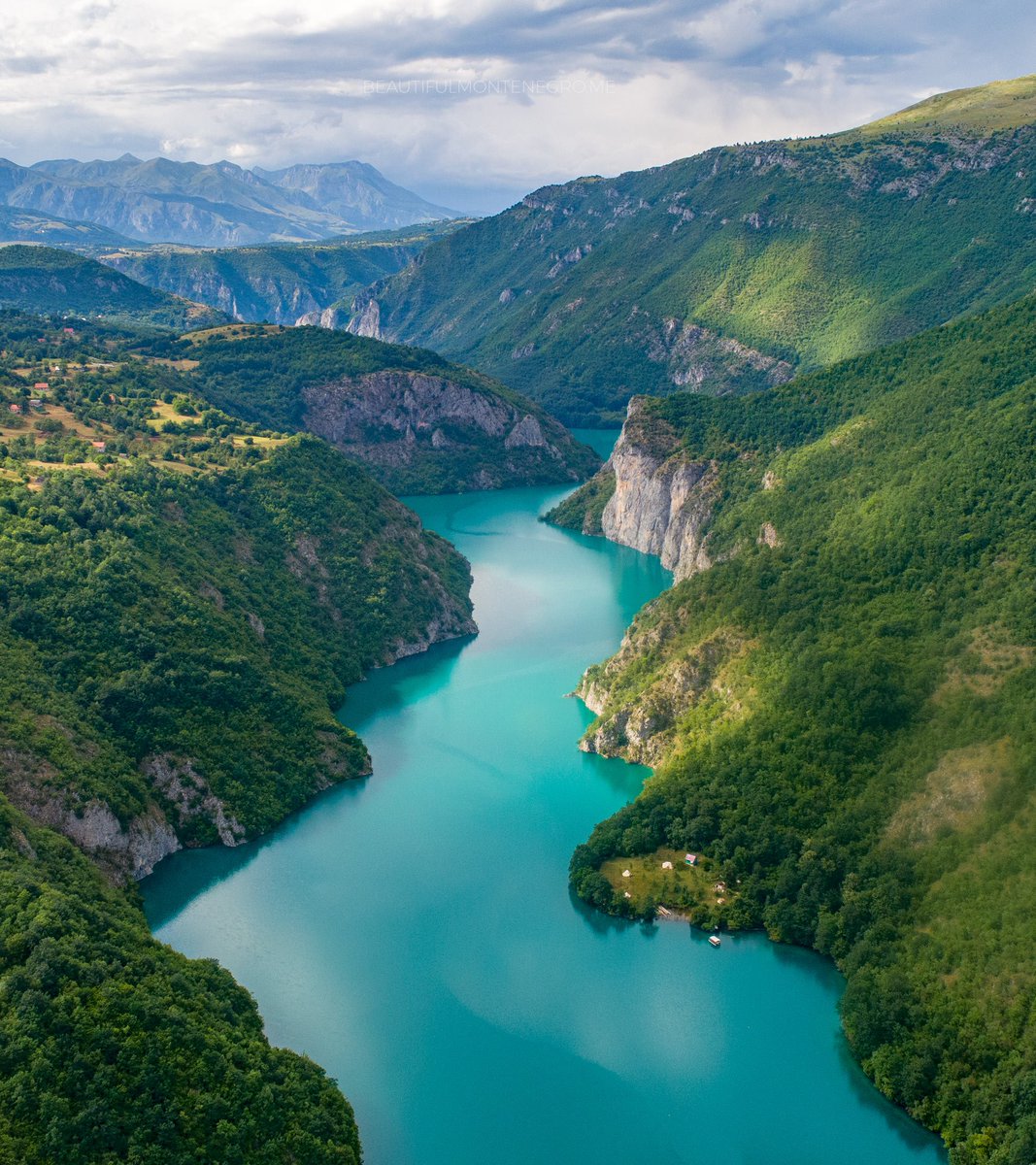Montenegro – Northern (Kolašin, Bijelo Polje, Pljevlja) May 9-11, 2019
Observations on Montenegro
1. Buy gas in N Macedonia where it is €1.15 on average – in Montenegro, it is €1.25/lire on average.
2. English skills are poor. When in line at Osrod, and standing touching at least 4 other bodies, some 16-year-old girls could barely converse with me.
3. It is a very religious country (Serbian Orthodox). Being a non-believer even as a teenager would not be great.
Currency – €
I continued onto Montenegro from White Drin waterfall. From the waterfall turn-off, it was about 20 km up a long switchbacking road (that never seemed to end) to the Montenegro border check at the top of the mountains. Snow was beside the road.
This border crossing into Montenegro was painless compared to my first time when they would not accept my duplicate vehicle car insurance green card and I was required to purchase new insurance.
Google Maps navigation started instantly after crossing the border. I was kind of surreal. It was a 15km descent to Rozaje.
ROZAJE
Ganića Kula. In the NM “Castles and Forts” series, it is surrounded by new houses and is a small (12m on a side), 4-story square, stone tower (4th story wood with a balcony and small glass windows) that looks like it has been recently restored. There were no signs indicating opening times and I assume is not open to the public.
Sultan Murat II Mosque. Relatively modern, it has two limestone minarets with black conical roofs. The inside is spectacular. All the walls are tiled with different patterned tiles for the walls, round columns and around the window frames. The mihrab and mimbar are also tiled. Square in shape, the large dome has the usual geometric/flower motifs with a large brass chandelier. Unlike most Christian churches, many mosques have bathrooms. I used this one.
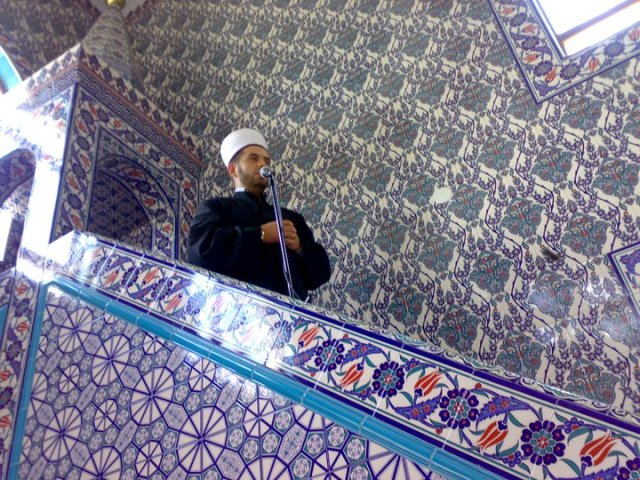
It was then a 31km drive through lovely country, conifer forests, green grassy fields and several tunnels descending to Burane.
Polimski Muzej, Berane. This could be called the city museum with artifacts and history of Berane and Gornje Polimlje, the surrounding area. It is divided into several collections: archaeological, historical, ethnological, heraldic and an arms collection. €2
KOLAŠIN
This small city was a significant distance out of my way. But there were two monuments here.
Kolašin Monument, Kolašin. In the main city square called the Square of Fighters is a large statue of a man holding a rifle in one hand and a flag aloft and a woman holding a rifle and pointing with her left arm. Surrounding it on elevated grass platforms are busts of 4 men and 1 woman with dates of death from 1942-44. Two other busts are from 1975 and 1994. The actual name of the monument may be the “Monument to Fallen Partisans”.
Vlahovic Monument In the town on a smaller square is a grandiose monument to Veljko Vlahovic, a fighter from the Spanish war, from the Yugoslavian FLF, and a distinguished politician from Kolasin.
’Biogradska gora’ National Park. A tentative WHS (09/11/2010), it is 54 km² in area in the Bjelasica Mountain Range includes untouched forest with trees over 500 years old, large mountain slopes and tops over 2,000 meters high, six glacial lakes, five over 1,820 meters high one easy accessible low land lake located at the very entrance to the park, Biogradsko Lake. The headquarters is in Kolašin.
Proclaimed as a National Park in 1952, it has a visitors center, hiking trails, campsites, and a restaurant.

On the way to Tara Canyon, while driving the same road for 20 km that I took to Kolašin, I passed a fellow on a solid line and went over the hard-to-understand speed limit of 40 km/hour. Unfortunately, there was a policeman right there who wanted me to return to Kolašin to pay the €70 ticket. I whined, asked for a warning, discussed my travel and whined some more telling him I would think highly of Montenegro police if he let me off. Finding out that I was Canadian and a doctor was the winning element and he let me go. What a nice chap.
Tara River Canyon. Between Bistrica in Montenegro to Hum in Bosnia and Herzegovina, it is 82 kilometres (51 miles) long, with the last 36 kilometres forming the border between Bosnia and Herzegovina and Montenegro. The canyon at its deepest is around 1,300 meters (4,300 feet) deep, making it one of the deepest river canyons in Europe. The canyon stretch within Montenegro is protected as a part of Durmitor National Park and is a UNESCO World Heritage Site.
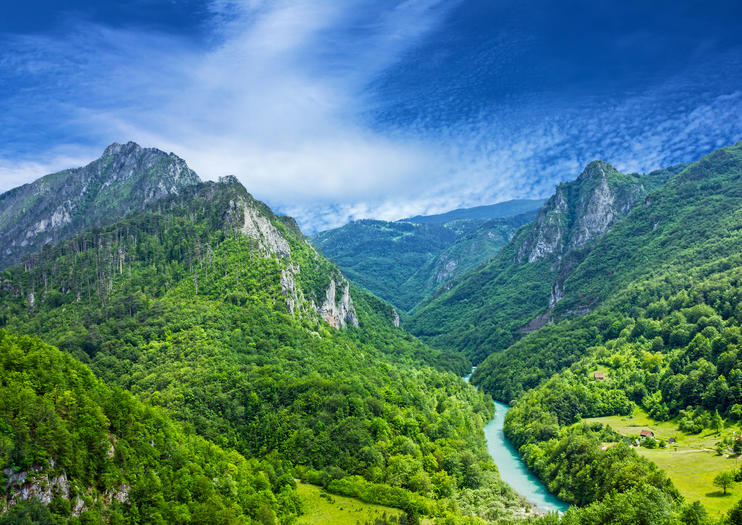
It has many cascades in the whitewater category 2 and 4.
The governments of Montenegro and Republika Srpska entity in Bosnia and Herzegovina had plans to flood the Tara River and a considerable part of its gorge, with the construction of at least one and possibly more hydroelectric dams on the Drina and possibly the Tara itself. A plan to construct dams in Bosnia and Herzegovina on the Drina River has never been shelved completely.
Rafting. The canyon is part of the one-day Tara River rafting route from Brstnovica to Sćepan Polje, is 11 mi long and it takes 2 to 3 hours. There are 21 rapids including the very dangerous Celije and Vjernovički rapids.
There is one particularly good viewpoint (with no close pull-off) where the canyon may be its deepest and has yellow vertical walls. The drive drops from here and often is down near the emerald green water. The tourist highlight is the Đurđevića Tara Bridge, on the crossroads between Mojkovac, Žabljak and Pljevlja. It is 165 metres high and thronged with tourists.
Several zip lines travel completely across the wide gorge here.
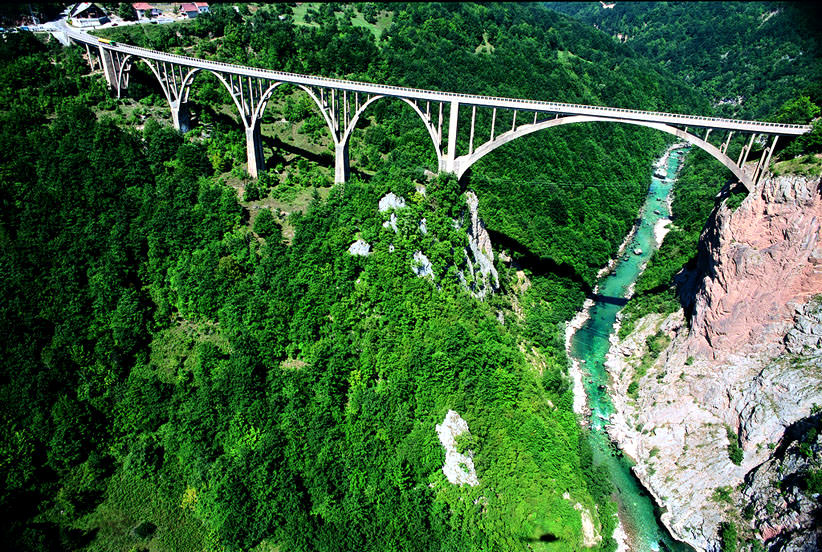
Several miles downstream and a day later I crossed the Tara and followed it downstream when I entered Bosnia and Herzegovina.
Durmitor National Park. The impossibly rugged and dramatic Durmitor is one of Montenegro’s – and Mother Nature’s – showpieces. Carved out by glaciers and underground streams, Durmitor stuns with dizzying canyons, glittering glacial lakes and nearly 50 limestone peaks soaring to over 2000m; the highest, Bobotov Kuk, hits 2523m. From December to March, Durmitor is a major ski resort, while in summer it’s popular for hiking, rafting and other active pursuits.
The national park covers the Durmitor mountain range and a narrow branch heading east along the Tara River towards Mojkovac. West of the park, the mighty Tara marks the border with Bosnia and joins the Piva River near Šćepan Polje.

Durmitor is home to 163 bird species, about 50 types of mammals and purportedly the greatest variety of butterflies in Europe. It’s very unlikely you’ll spot bears and wolves.
NikŠić. This is an NM European City. I slept here on the street across from a burger restaurant and used their wi-fi.
OSTROG MONASTERY
Actually in NM Montenegro South, it is only 20 road kilometres south of NikŠić.. I picked a bad day to go here, Saturday, May 11, the day before the monastery celebrates its feast day on 12 May every year. St Basil died on 29 April in the Orthodox calendar which equates to 12 May in the Gregorian calendar.
I was passing young adults carrying daypacks and sleeping bags at least 6 km before the monastery and possibly passed 100. It is a big climb up here as the monastery sits at the base of a vertical cliff almost at the top of the mountain. Basically, there ended up being several thousand camped all over wherever there was a flat spot. It is necessary to park down below and walk up either the faster stairs or on the road with its long switchbacks. At the last switchback just before the monastery, bodies were everywhere.
I joined the line up to enter the monastery (don’t enter the candle/water line), at least 30 people across that narrowed in 40m to 4 across on the stairs. After an hour, I had moved about one metre and that was only by some aggressive movements. I talked to three 16-year-olds with faltering English who filled me in. Nobody in their religious devotion seemed to mind standing still. Finally, I decided to leave, it would have been 5-8 hours to finally get in. On leaving I talked to a woman from Switzerland who seemed OK with the situation. When I gave her my website address, she, for the first time ever, mentioned Laurent-Perrier champagne, a very high-end champagne that was her favourite (she looked like a high-maintenance woman). She asked a guard for me if I could go in the exit line (that nobody exited) for a 10-second look, but that was not possible.
I have seen innumerable orthodox churches and this would have probably been rather ordinary but with icons and a reliquary of St Basil that everyone would cross themselves 10 times, kiss and touch the floor in front of.
The Monastery of Ostrog is a monastery of the Serbian Orthodox Church situated against an almost vertical background, high up in the large rock of Ostroška Greda. It is dedicated to Saint Basil of Ostrog (Sveti Vasilije Ostroški), who was buried here. From the monastery, a superb view of the Bjelopavlići plain can be seen. The monastery is 50 km from Podgorica and 15 km from Nikšić. Ostrog monastery is the most popular pilgrimage place in Montenegro.
The Monastery was founded by Vasilije, the Metropolitan Bishop of Herzegovina in the 17th century. He died there in 1671 and some years later he was glorified. His body is enshrined in a reliquary kept in the cave church dedicated to the Presentation of the Mother of God to the Temple.
The present-day look was given to the Monastery in 1923-1926, after a fire that had destroyed a major part of the complex. The two little cave-churches were spared and they are the key areas of the monument. The frescoes in the Church of the Presentation were created towards the end of the 17th century. The other church, dedicated to the Holy Cross, is placed within a cave on the upper level of the monastery and was painted by Master Radul, who successfully coped with the natural shapes of the cave and laid the frescoes immediately on the surface of the rock and the south wall. Around the church are the monastic residences, which together with the church building and the scenery make this monument outstandingly beautiful.
During World War II, a detachment of Chetniks took refuge at Ostrog up to October 18, 1943, when Yugoslav Partisans promised the Chetniks that their lives would be spared if they surrendered. The 23 Chetniks peacefully surrendered, expecting to be spared, but were all killed by the Partisans at Ostrog. Stanišić and three members of his extended family initially did not surrender but did not survive at Ostrog.
The Orthodox monastery of Ostrog is one of the most frequently visited in the Balkans. It attracts over 100,000 visitors a year. It is visited by believers from all parts of the world. It represents the meeting place of all confessions: the Orthodox, the Catholics and the Muslims. According to the stories of pilgrims, by praying to his body, many have been cured and helped in lessening the difficulties in their lives.
Upper Monastery. The upper monastery houses the Church of the Presentation and the Church of the Holy Cross. Saint Basil of Ostrog’s relics lie in the Church of the Presentation. Also of interest is the vine which grows out of the rock. It’s said that it’s a miracle because nothing should be able to grow out of the sheer rock face.
Lower Monastery. The lower monastery centers around the Church of the Holy Trinity which was built in 1824. It also makes up most of the monk’s residences. There are dorm rooms available for pilgrims here too.
Traditions. It is traditional for pilgrims to walk the 3 km from the lower monastery to the upper monastery barefoot. Before entering the Church of the Presentation to pray before Saint Basil of Ostrog, pilgrims make a donation of clothing, blankets or consumables like soap for the monks. The monastery celebrates its feast day on 12 May every year. St Basil died on 29 April in the Orthodox calendar which equates to 12 May in the Gregorian calendar.
In many respects, it was an enlightening experience even if I did not get to go into the church. The vast majority of the people here were less than 25, unusual to see such religious devotion in so many of this age anywhere in the world. But religious ‘penetration’ is deep here with few acknowledged atheists. Just like in India of Pakistan, it does not work well to be a non-believer. On the other hand, it could have been just a chance to camp out on a weekend and be with your friends. The vast majority had one fleece blanket and few tents. It would have been havoc if it rained.
Instead of returning on the same road, I took the exit road to the south towards Podgorica and drove 40 kilometres longer to get back to Niksic. I slept in NikŠić and started driving at 07:00 to enter Bosnia and Herzegovina.
E762: Podgorica-Plužine. On the way to Bosnia, this is a gorgeous road, one of the scenic highlights of the world. You are above and drive beside Lake Pivsko, a 43km long reservoir under soaring rugged limestone walls. The lake holds 800 cubic metres of water and is the largest in the Balkans.
The road goes through innumerable rough, dark tunnels. The lake ends at the Pivsko Dam, a mammoth concrete arc construction 220m high, with an arc length of 268m at the top and 40m at the bed. It was completed in 1976 and annually generates 860 GWA of electricity. The original road can be seen about halfway down the cliffs snaking through innumerable tunnels. That would have been a trip.
Cross the canyon on the dam and then back to the east side on another high bridge. The scenery continues to be wonderful at the Bosnia-Herzegovina border.
There were no issues at the border. Cross the Tara River almost immediately – it forms the border between the two countries.
